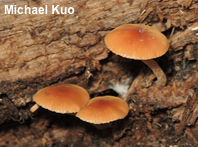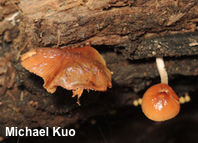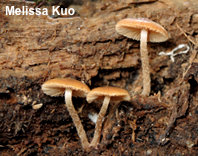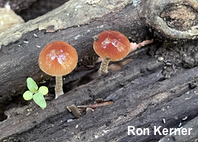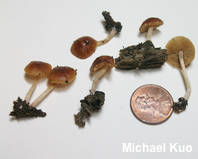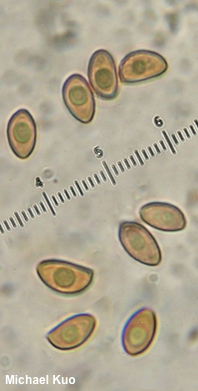| Major Groups > Gilled Mushrooms > Dark-Spored > Bolbitius > Bolbitius species 01 |

|
[ Basidiomycota > Agaricales > Bolbitiaceae > Bolbitius . . . ] Bolbitius species 01 by Michael Kuo, 6 November 2023 This apparently undescribed species of Bolbitius appears in the Midwest, in summer, on well-decayed hardwood logs in bottomland forests. It features a dark reddish brown to orange-brown cap that is sticky when fresh, and becomes lined or grooved from the margin nearly to the center. Its gills are cinnamon brown at maturity, and its ringless stem is brownish and pruinose. Under the microscope it features medium-sized, smooth spores with a very tiny pore. Bolbitius callistus, described by Peck from New York (1873) and later from the Midwest (Watling & Miller 1987) and eastern Europe (Kalinina et al. 2021), is very similar in middle and advanced stages of maturity—but its cap is deep blue when young, becoming olive and, eventually, more or less the color of the species described here: orangish brown. Additionally, Bolbitius callistus has larger spores. Europe's Bolbitius psittacinus is also similar, but features a larger, more conical cap that is red to black, blue, or green when young—and, again, larger spores. Thanks to Ron Kerner for documenting, collecting, and preserving Bolbitius species 01 for study; his collection is deposited in The Herbarium of Michael Kuo. Description: Ecology: Saprobic on the well-decayed deadwood of hardwoods; found in lowland woods, growing gregariously; summer; distribution uncertain. The illustrated and described collections are from Illinois and Indiana. Cap: 1.5–3 cm; convex, becoming planoconvex; dark orange-brown to dark reddish brown, fading to pale orangish brown or tan; sticky when fresh; bald; strongly lined, nearly all the way to the center. Gills: Broadly attached to the stem; close; short-gills frequent; very pale brown at first, becoming dull cinnamon brown. Stem: 2–4 cm long; 2–3 mm thick; equal; fragile; hollowing; finely pruinose, with flecks near the apex; whitish to brownish; basal mycelium white. Flesh: Insubstantial; brownish; unchanging when sliced. Odor: Slightly fragrant when flesh is crushed. Chemical Reactions: KOH on cap surface gray. Spore Print: Dull cinnamon brown. Microscopic Features: Spores 7–9 x 4–5 µm; subamygdaliform to subellipsoid; with a very small pore; smooth; yellow-brown in KOH. Basidia 28–32 x 6–8 µm; clavate; 4-sterigmate. Brachybasidioles not found. Cheilocystidia 25–32 x 3–5 µm; irregularly cylindric, with clavate to subclavate, subcapitate, or merely rounded apices; smooth; thin-walled; hyaline in KOH. Pleurocystidia not found. Pileipellis hymeniform; terminal cells 25–37 x 8–12 µm; obpyriform to capitate; smooth; hyaline to brownish in KOH. Caulocystidia 20–45 x 7.5–10 µm; clavate or irregularly clavate; smooth; thin-walled; hyaline in KOH. Clamp connections not found in lamellar trama or pileus context; occasional and inconspicuous in stipitipellis. REFERENCES: (Peck, 1873; Watling, 1982; Watling & Miller, 1987; Arnolds, 2005; Malysheva et al., 2015; Hausknecht & Vesterholt, 2018; Kalinina et al., 2021.) Herb. Kuo 07091601, 07222202. This site contains no information about the edibility or toxicity of mushrooms. |
© MushroomExpert.Com |
|
Cite this page as: Kuo, M. (2023, November). Bolbitius species 01. Retrieved from the MushroomExpert.Com Web site: http://www.mushroomexpert.com/bolbitius_species_01.html |
